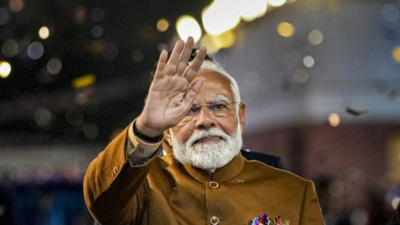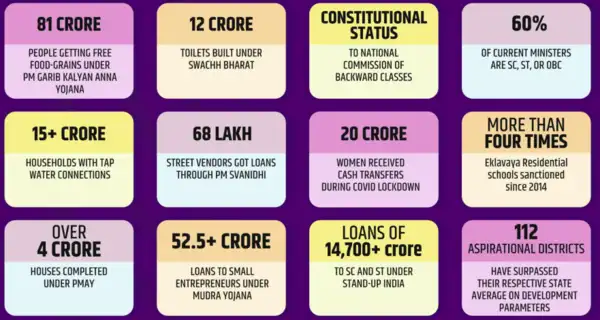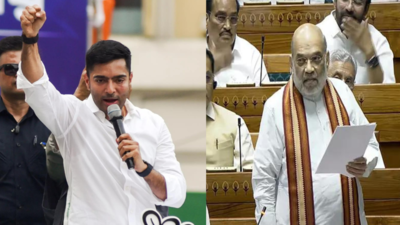From Awas Yojana to scrapping of Article 370: 11 big achievements in 11 years of PM Modi government | India News

NEW DELHI: The Modi government marked the completion of one year in its third term and 11 years in office overall on June 7, 2025. Based on official data, here are 11 notable accomplishments from 2014 to 2025 that have shaped India’s trajectory over the past decade under the BJP-led NDA government.Serving the poor and honouring the marginalised at the heart of governanceOver the past 11 years, the Modi government has expanded its welfare outreach to historically underserved communities. 81 crore people have been receiving free food grains under the PM Garib Kalyan Anna Yojana, while over 12 crore toilets have been built under Swachh Bharat. A report released by the Bharatiya Janata Party (BJP) also notes that 15 crore households now have tap water connections, and more than 4 crore homes have been completed under PMAY. Financial empowerment has also been a focus—over 52 crore loans have been given under the Mudra Yojana, 68 lakh street vendors were supported through PM SVANidhi, and 20 crore women received cash transfers during the Covid lockdown. Notably, 60 per cent of current ministers are from SC, ST, or OBC communities, and 112 aspirational districts have shown development progress above the state average.

Ensuring farmer welfare: Investing in the backbone of India’s economyOver the last 11 years, the Modi government has significantly scaled up its support for farmers, both in policy focus and budgetary allocation. The agriculture budget in 2025–26 rose to five times its 2013–14 levels. Nearly 25 crore soil health cards have been distributed to promote scientific farming practices. Under the PM Kisan scheme, Rs 3.7 lakh crore has been disbursed directly to farmers, while over Rs 1.75 lakh crore has been settled under PM Fasal Bima Yojana claims, giving financial protection against crop loss. Procurement at Minimum Support Price (MSP) has seen a 7,350 per cent rise for pulses and 1,500 per cent for oilseeds. Infrastructure support has also increased—Rs 1 lakh crore has been disbursed through the Agriculture Infrastructure Fund, and 1,473 mandis have been linked through eNAM to streamline produce marketing.

New momentum for Nari ShaktiOver the past 11 years, the Modi government has focused on empowering women through targeted schemes, legal safeguards, and economic inclusion. For the first time, India has recorded a sex ratio of 1,020 women per 1,000 men (NFHS-5). Under the PMMVY, Rs 18,593 crore has been distributed to 3.98 crore pregnant and lactating women. The Ujjwala Yojana has enabled over 10.33 crore households to shift to smoke-free kitchens, improving women’s health. Paid maternity leave was extended from 12 to 26 weeks. Over 35 crore Mudra loans — amounting to Rs 14.72 lakh crore — have been given to women, accounting for 68 per cent of the total disbursement.Additionally, 10 crore women have been brought into more than 90 lakh Self Help Groups, while the government has pledged to support 3 crore women in becoming “Lakhpati Didis”.

Building a future-ready generationWith an eye on India’s long-term growth, the Modi government has placed a strong emphasis on nurturing the “Amrit Peedhi” — the youth of India — through a combination of education reform, skill development, entrepreneurship support, and sports infrastructure. The National Education Policy (NEP), introduced after more than 30 years, has laid the foundation for a more flexible, modern learning environment. Over 1.6 crore individuals have been trained under the PM Kaushal Vikas Yojana. In the startup ecosystem, more than 1.6 lakh startups have been officially recognised, generating 17.6 lakh+ jobs. In the realm of education infrastructure, 14,500 schools are being modernised under the PM SHRI scheme; 7 new IITs and 8 new IIMs have been added, bringing their total to 23 and 21 respectively. The number of AIIMS has tripled, and 2,045 medical colleges (including allopathy, dental, and AYUSH) are now operational. The government has also focused on sports through the TOPS (Target Olympic Podium Scheme), supporting 94 athletes in the core group and contributing to India’s rising medal tally in global events.

Rapid growth in infrastructureIndia’s infrastructure landscape has transformed remarkably over the past 11 years, marked by rapid expansion and modernization. Road transport and highway budgets saw a massive 570% surge between 2014 and 2023-24, while the rural road network now covers 3.96 lakh km with 99% connectivity. The speed of highway construction has climbed to an impressive 34 km/day. Railways too witnessed a nine-fold budget hike, facilitating the launch of 400 Vande Bharat trains. Urban mobility progressed with metro rail networks growing from 248 km in 2014 to 1,013 km in 2025. Additionally, 86 airports have been operationalized, and over 3,600 km of high-speed corridors have been built in the last five years, underscoring the government’s focus on building infrastructure at an unprecedented scale and pace.

Nation firstIndia’s commitment to national security and global diplomacy was underscored through landmark operations and decisive reforms. The success of Operation Sindoor and Operation Kaveri reflected a resolute and sovereign nation prioritizing the safety of its citizens worldwide. Defence exports surged to Rs 23,622 crore in 2024–25, alongside a 34-fold rise since 2014. Strategic decisions like the removal of Articles 370 and 35A and the conversion of the Ordnance Factory Board into seven PSUs, six of which are profitable, demonstrate a robust defence posture.

India becoming economic powerhouseIndia has emerged as a global economic powerhouse, with FDI jumping to $42 billion, crossing $1 trillion cumulatively. India leads in real-time digital transactions (49 per cent globally) and is projected to be the fastest-growing major economy. The PLI scheme generated Rs 14 lakh crore in output and 11.5 lakh jobs. With NPAs down to 2.6 per cent and MSMEs receiving over Rs 3.68 lakh crore, India’s robust, tech-driven, and inclusive growth is reshaping the global economic landscape.

Ease of doing businessIndia has significantly improved its ease of doing business, rising 79 ranks between 2014 and 2019. Over 1.8 lakh new companies were registered in 2023–24, supported by tax reforms, labor code simplifications, and the repeal of archaic laws. The country also witnessed a seventeen-fold rise in patent grants, reflecting a more innovation-friendly business environment.

Preserving cultureThe government in the past 11 years has also prioritized the conservation of India’s rich cultural heritage through major redevelopment initiatives and restoration projects. Iconic sites like Kedarnath, Somnath, and Ram Mandir have seen renewed focus, while over 640 stolen artefacts have been brought back since 2014. Through schemes like Swadesh Darshan and the HRIDAY project, 76 thematic circuits and 12 heritage cities are being developed. Events like Azadi Ka Amrit Mahotsav and the opening of Kartarpur Corridor further celebrate India’s spiritual and historical legacy.

Digital revolutionIndia’s digital revolution is redefining scale and reach. With 116 crore mobile subscribers and 6.93 lakh km of optical fibre laid under BharatNet, the country’s connectivity push is unprecedented. Over 2.14 lakh gram panchayats are now connected via fibre, and 5.76 lakh Common Service Centres are operational under Digital India. Affordable internet has become a reality, with data prices dropping from Rs 308 per GB to just Rs 9.34. Meanwhile, the UPI ecosystem hit Rs 24 lakh crore in transactions in April 2025 alone, accounting for 49 per cent of global real-time digital payments.

Empowering middle-classIn the past 11 years, India’s middle class has witnessed a significant transformation in quality of life, marked by impactful reforms and digital inclusion. Over 4 crore urban and rural homes have been built under the PM Awas Yojana, while income tax rebates under the new tax regime now extend up to Rs 12.75 lakh, offering substantial relief to salaried families. Affordable internet data—with a 97% drop in cost—and widespread 5G rollout in 99.6% of districts have made connectivity more accessible than ever.






